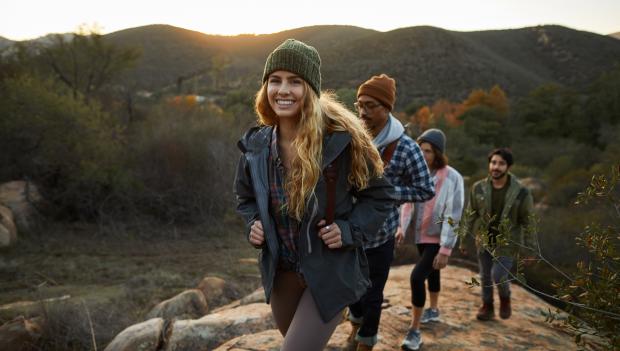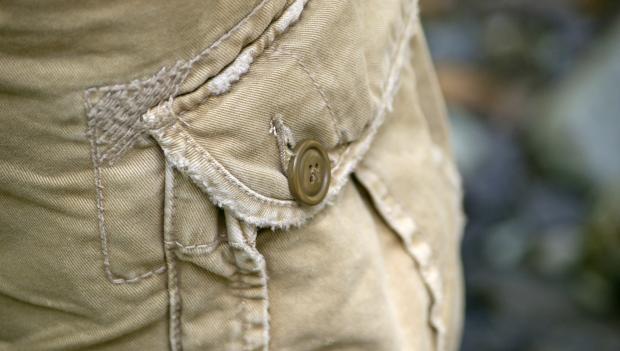
There’s a whole universe of camping gear to choose from and arguably none is more important than clothing. The right clothes can keep you comfortable no matter the type of camping or conditions. It doesn’t matter if you’re preparing for a relaxing weekend in an RV, a grueling long-haul backpacking trip, or something in between, the same principles apply in choosing your clothing: consider your fabrics, layer up, and sweat the garment’s details.
Recommended: Gear Guide: Must-Have Items for Every Adventure
Think Fabrics
The fabrics you prefer for lounging around, like cotton and silk blends, are not your best choices for camping. These fabrics do not efficiently wick moisture away from your body. The result is damp or wet clothes that stick to you. When it’s hot out, this can make you clammy and uncomfortable. In cool weather, you’ll be unnecessarily chilly. In freezing temperatures, wet clothing can be dangerous.
Instead, wear clothing that’s either made of wool or synthetic fibers like polyester. Both of these fabrics are moisture-wicking. Wool has the advantage of reducing odors and can be worn multiple times without the need for washing. Polyesters are faster-drying than wool, although they can start to smell after one wear.

Layer Up
Over the course of your camping trip, the weather is bound to change. Even the hottest summer days can see a quick dip in the thermostat or a sudden downpour. Polar-like days may have a burst of sun and then a rush of freezing wind. You have to be ready for it all. This is where layers are your lifeline. Here are different layers in order from inner to outer wear:
Base Layers – worn mostly in cold weather, the base layer is closest to your skin and provides warmth while wicking away sweat. Base layers come in various weights – usually light, medium, and heavy – for cool to sub-freezing temperatures. Some micro weight base layers can be worn in warm weather and feature an SPF.
Shirts and Pants – the main consideration with shirts and pants is how appropriate they are, specifically their durability and functionality, for your planned activities. If you’ll be hiking and boulder scrambling, you want well-constructed shirts and pants that stand up to poking branches and abrasive rocks (i.e., not yoga pants). If you’re a parent, you’ll likely want bottoms with convenient and roomy pockets to quickly get out or stash away lip balm, wipes, or even small toys for the kids.
Recommended: Outdoor Winter Fun Ideas
Mid Layers – this layer is needed in cooler weather and includes fleeces, vests, and insulated jackets. Fleeces are incredibly versatile and can be used as active or sleep wear. Vests are great to throw on if you need additional warmth, but don’t want to restrict your arm movements. Insulated jackets come in a range of materials, and should be chosen based on their warmth and compatibility. For instance, if you plan on hiking in inclement weather, consider a puffy down jacket that packs down for easy storage in your hiking sack.
Consider mid and base layers on your feet too. Sock liners (in addition to warm socks) can do wonders in keeping you warm.
Outerwear – it’s important to keep in mind the difference between water-resistant and water-proof outerwear. Water-resistant clothing will help block precipitation for a short period of time, but isn’t designed to hold up for extended durations in rain, sleet, and snow like water-proof clothing will. Water-resistant outerwear includes soft shell jackets (although these may also be worn as a mid layer under a rain jacket). Rain jackets and water-proof pants should be your go-to outerwear if there’s any chance of precipitation in the forecast.
Accessories – don’t forget your beanies, scarves, neck gaiters, and socks! You may want ones that are thick or thin, or tall or short, depending on the weather, planned activities, and your personal preference. You’ll also likely need hats, bandanas, gaiters, gloves, and sunglasses. These items will help regulate your temperature and protect you from mother nature.
Recommended: 15 Natural Attractions You Have to See to Believe

Sweat the Details
Camping clothes need to work hard for you since you’ll likely wear the same items multiple times in a range of situations. That puffy jacket you throw on for snowshoeing during the day will also probably be the one you wear by the campfire at night.
When buying camping clothes, pay attention to each garment’s details. Pockets, for example, are a detail you may not care much about with your everyday clothes, but are super important when camping because they allow you to store your gear on you. How many pockets does a clothing item have, how big are they, and where are they placed?
What about the zippers, closures, clasps, hoods, and vents? Is the item easily adaptable to different situations, like convertible pants-shorts or headwear that can double as a hat or scarf? There are also speciality features to consider. For instance, some clothing items have SPF ratings, while others repel insects.
Ultimately, your camping clothes must be supremely comfortable. Try the clothes on in the house for a bit before throwing them into your camping bag. Make sure they move with you, are the right weight, and fit perfectly – that is, in a way that makes you want to put them on whenever you have the chance.
Are you ready for your adventure? Plan your camping trip!
Check with your Local Government Organization
Many policies have been established to counter and control the coronavirus outbreak. State and local officials have been taking decisive action to stop the spread. The policies vary by state, sometimes to a great degree. When you book a reservation, make sure to review the park and state’s latest rules and regulations prior to your visit.
For COVID-19 updates, please visit our Impacted Park List and Reservation Guide for the latest information.